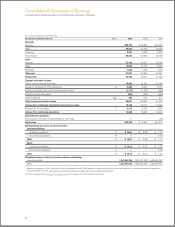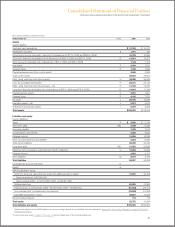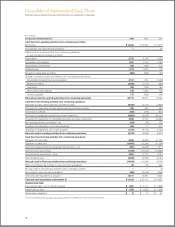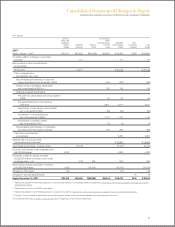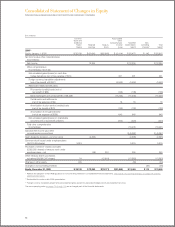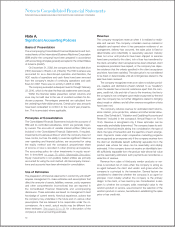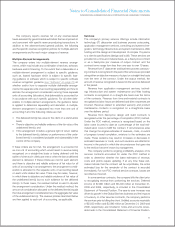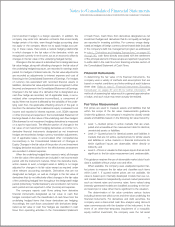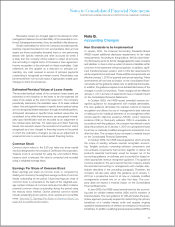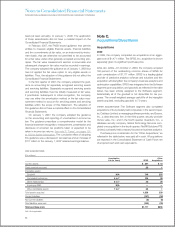IBM 2009 Annual Report Download - page 76
Download and view the complete annual report
Please find page 76 of the 2009 IBM annual report below. You can navigate through the pages in the report by either clicking on the pages listed below, or by using the keyword search tool below to find specific information within the annual report.
Notes to Consolidated Financial Statements
INTERNATIONAL BUSINESS MACHINES CORPORATION AND SUBSIDIARY COMPANIES
Advertising and Promotional Expense
The company expenses advertising and promotional costs
when incurred. Cooperative advertising reimbursements from
vendors are recorded net of advertising and promotional
expense in the period the related advertising and promotional
expense is incurred. Advertising and promotional expense,
which includes media, agency and promotional expense, was
$1,252 million, $1,259 million and $1,242 million in 2009, 2008
and 2007, respectively, and is recorded in SG&A expense in the
Consolidated Statement of Earnings.
Research, Development and Engineering
Research, development and engineering (RD&E) costs are
expensed as incurred. Software costs that are incurred to pro-
duce the finished product after technological feasibility has been
established are capitalized as an intangible asset. See “Software
Costs” on page 73.
Intellectual Property and Custom Development Income
The company licenses and sells the rights to certain of its intel-
lectual property (IP) including internally developed patents, trade
secrets and technological know-how. Certain transfers of IP
to third parties are licensing/royalty-based and other trans fers
are transaction-based sales and other transfers. Licensing/
royalty-based fees involve transfers in which the company earns
the income over time, or the amount of income is not fixed
or determinable until the licensee sells future related products
(i.e., variable royalty, based upon licensee’s revenue). Sales and
other transfers typically include transfers of IP whereby the com-
pany has fulfilled its obligations and the fee received is fixed or
determinable at the transfer date. The company also enters into
cross-licensing arrangements of patents, and income from these
arrangements is recorded only to the extent cash is received.
Furthermore, the company earns income from certain custom
development projects for strategic technology partners and
specific clients. The company records the income from these
projects when the fee is realized or realizable and earned, is not
refundable and is not dependent upon the success of the project.
Other (Income) and Expense
Other (income) and expense includes interest income (other
than from Global Financing external business transactions),
gains and losses on certain derivative instruments, gains and
losses from securities and other investments, gains and losses
from certain real estate transactions, foreign currency transaction
gains and losses, gains and losses from the sale of businesses
and amounts related to accretion of asset retirement obligations.
Business Combinations and
Intangible Assets Including Goodwill
The company accounts for business combinations using the
acquisition method and accordingly, the identifiable assets
acquired, the liabilities assumed, and any noncontrolling interest
in the acquiree are recorded at their acquisition date fair values.
Goodwill represents the excess of the purchase price over
the fair value of net assets, including the amount assigned to
identifiable intangible assets. The primary drivers that generate
goodwill are the value of synergies between the acquired enti-
ties and the company and the acquired assembled workforce,
neither of which qualifies as an identifiable intangible asset.
Identifiable intangible assets with finite lives are amortized
over their useful lives. Amortization of completed technology is
recorded in cost and amortization of all other intangible assets
is recorded in selling, general and administrative expense. See
note C, “Acquisitions/Divestitures,” on pages 82 to 86 and note
J, “Intangible Assets Including Goodwill,” on pages 89 to 90, for
additional information. Acquisition-related costs, including advi-
sory, legal, accounting, valuation and other costs, are expensed
in the periods in which the costs are incurred. The results of
operations of acquired businesses are included in the Consoli-
dated Financial Statements from the acquisition date.
Impairment
Long-lived assets, other than goodwill, are tested for impairment
based on undiscounted cash flows and, if impaired, written down
to fair value based on either discounted cash flows or appraised
values. Goodwill is tested annually, in the fourth quarter, for
impairment, or sooner when circumstances indicate an impair-
ment may exist, using a fair-value approach at the reporting
unit level. A reporting unit is the operating segment, or a busi-
ness, which is one level below that operating segment (the
“component” level) if discrete financial information is prepared
and regularly reviewed by management at the segment level.
Components are aggregated as a single reporting unit if they
have similar economic characteristics.
Depreciation and Amortization
Plant, rental machines and other property are carried at cost
and depreciated over their estimated useful lives using the
straight-line method. The estimated useful lives of certain depre-
ciable assets are as follows: buildings, 30 to 50 years; building
equipment, 10 to 20 years; land improvements, 20 years; plant,
laboratory and office equipment, 2 to 20 years; and computer
equipment, 1.5 to 5 years. Leasehold improvements are amor-
tized over the shorter of their estimated useful lives or the related
lease term, rarely exceeding 25 years.
Capitalized software costs incurred or acquired after tech-
nological feasibility has been established are amortized over
periods ranging up to 3 years. Capitalized costs for internal-use
software are amortized on a straight-line basis over periods up
to 2 years. (See “Software Costs” on page 73 for additional
information). Other intangible assets are amortized over periods
between 2 and 7 years.
74


